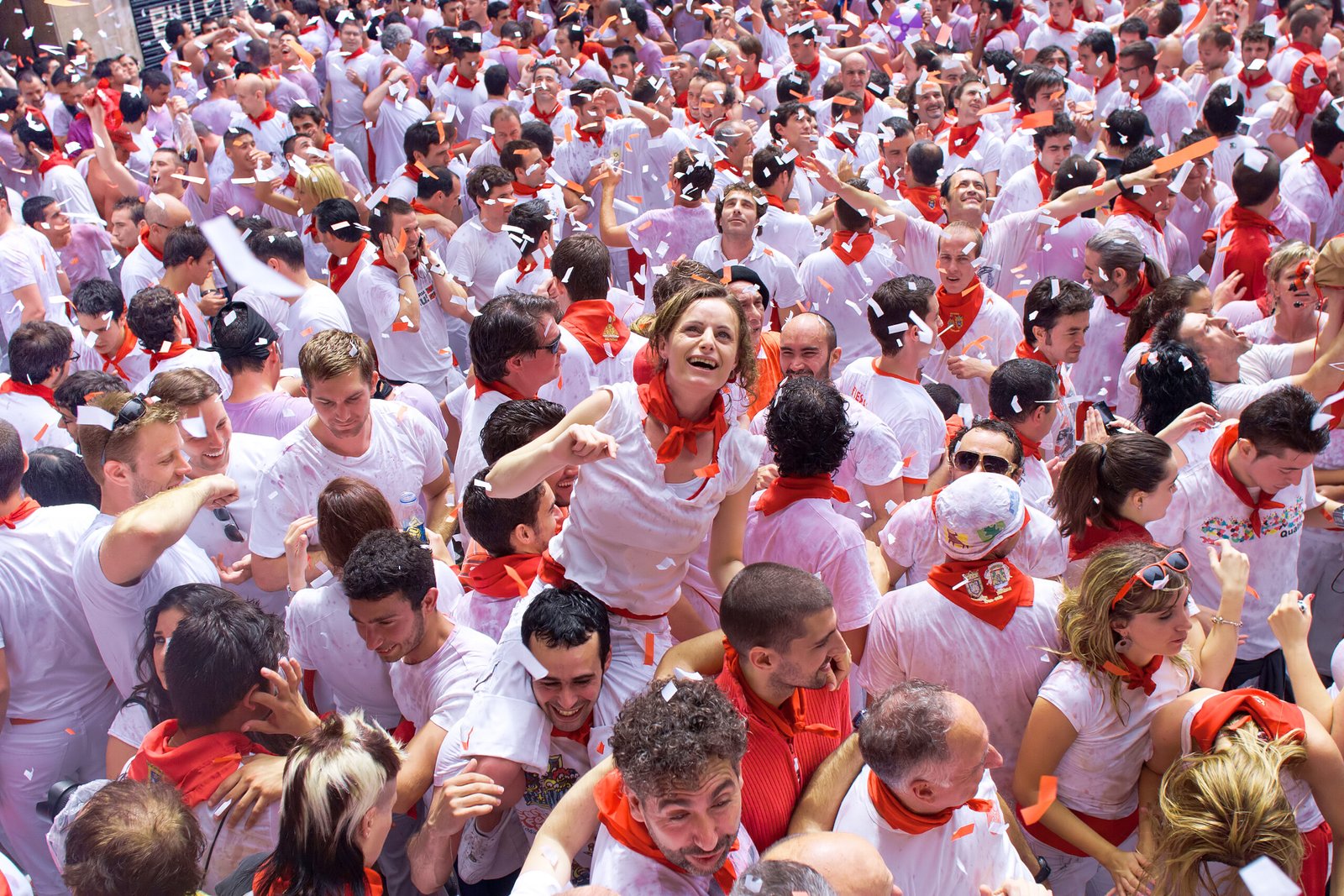Practical travel advice to plan your trip to experience the Running of the Bulls in Pamplona.
This article is part of a three-part San Fermín Cultural Series
Years ago, I found myself at 6 AM on cobblestones older than America, surrounded by 2,000 strangers in white clothing, about to run with six fighting bulls and nine steers through medieval Pamplona. I was only able to run about 100 meters of the 875 meter course, but looking back now, I see how that experience informs how I understand cultural travel, and why superficial tourism never satisfies sophisticated travelers.
Pamplona’s San Fermín Festival isn’t just about bulls, it’s a week long celebration of Basque heritage, Catholic faith, culinary artistry, and community bonds that stretch back centuries.
(From Part 1 of this series: A Personal Story from San Fermín)
Why This Cultural Traveler’s Guide to Experiencing San Fermín?
Most San Fermín advice treats the festival like an extreme sport. It’s not. Approach it as what it actually is: a profound cultural experience that deserves respect, understanding, and expert guidance. Not everyone can travel with Cosmopolitours, but everyone deserves to experience this event with insight and integrity. Whether you’re considering running, watching, or exploring Pamplona’s treasures beyond the bulls, this guide provides everything sophisticated travelers need for meaningful engagement.
This Guide Is Part 2 of Our Complete San Fermín Cultural Series:
Part 2: Pamplona Running of The Bulls 2026 Complete Travel Guide & Cultural Context
Where to stay, what to expect, and how to experience San Fermín respectfully. (YOU ARE HERE)
Part 3: Bullfighting and Tourism: Understanding Ethics, Spanish Perspectives, and Responsible Travel
A nuanced look at bullfighting’s legacy, evolving views, and ethical alternatives for travelers.
Ready to experience San Fermín authentically?
Our Pamplona cultural tours transform spectacle into meaningful cultural immersion.
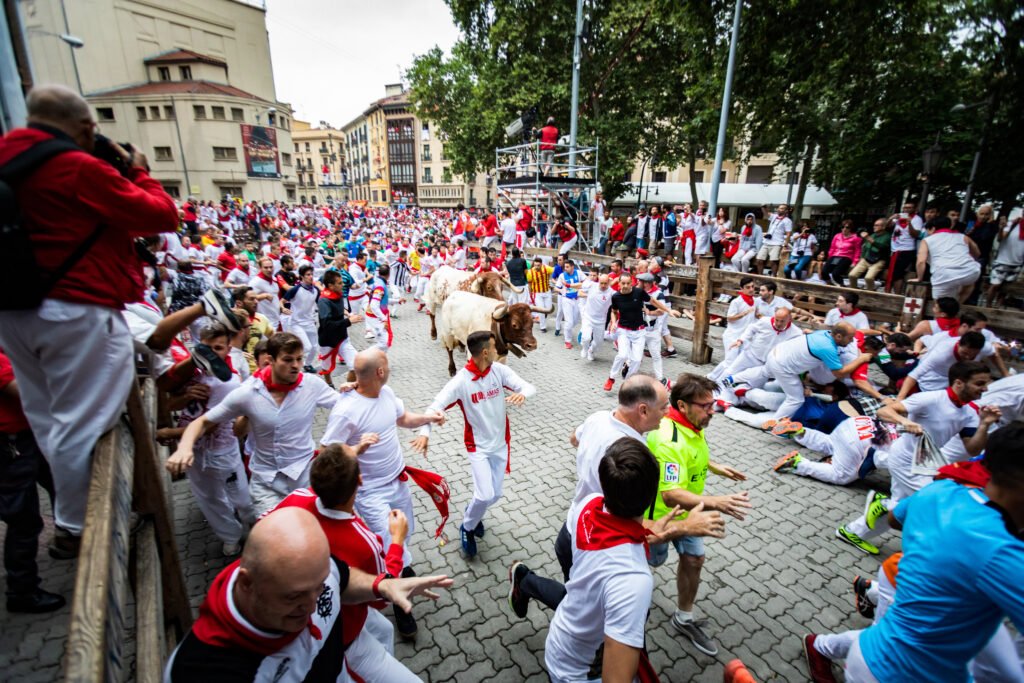
The encierro unfolds each morning of San Fermín, where runners face six bulls and six steers on Pamplona’s historic streets. At Cosmopolitours, we offer expert guidance to experience this powerful ritual with cultural insight and respect for its local meaning.
San Fermín Festival 2026: Essential Dates & Cultural Significance
San Fermín Quick Reference:
- Festival Dates: July 6-14, 2026 (identical dates annually)
- Opening Ceremony: July 6 at 12:00 noon (Chupinazo)
- Daily Bull Runs: July 7-14 at 8:00 AM sharp
- Route Distance: 825 meters through medieval Old Quarter
- Religious Foundation: Honoring San Fermín, Pamplona’s patron saint
- Cultural Reality: Bulls represent less than 5% of total festival activities
Mark your calendar: San Fermín maintains the same dates every year, July 6 through 14, regardless of the day of the week, according to Spain’s official tourism website. The festival pops to life precisely at noon on July 6 with the chupinazo, a rocket fired from Pamplona’s Town Hall balcony prompts thousands to erupt in celebration below, red scarves waving against medieval stone. This moment crystallizes what makes San Fermín special: ancient ritual building modern community.
Cultural Context That Matters: While international media focuses on bulls (thanks to Hemingway), the San Fermín festival is dedicated to honoring Saint Fermín, the patron saint of Pamplona and the surrounding Navarra region. Local families participate in religious processions, traditional celebrations, music sessions, and communal feasts that sustain their traditions across generations. Understanding this broader context is important and often overlooked.
The daily encierro (bull runs) occur at 8:00 AM from July 7-14, covering 825 meters of narrow streets in 2-6 minutes. More than 2,000 runners join six fighting bulls and accompanying steers on the sprint from Santo Domingo to Plaza de Toros.
Cosmopolitours Expert Take – Cultural Context: Our cultural guides help travelers understand the religious significance, regional identity, and community values that make San Fermín meaningful to Spanish families, context that enriches every moment of your experience. If you are planning your trip independently, we recommend investing time in cultural preparation by reading a book or watching a film about the festival.
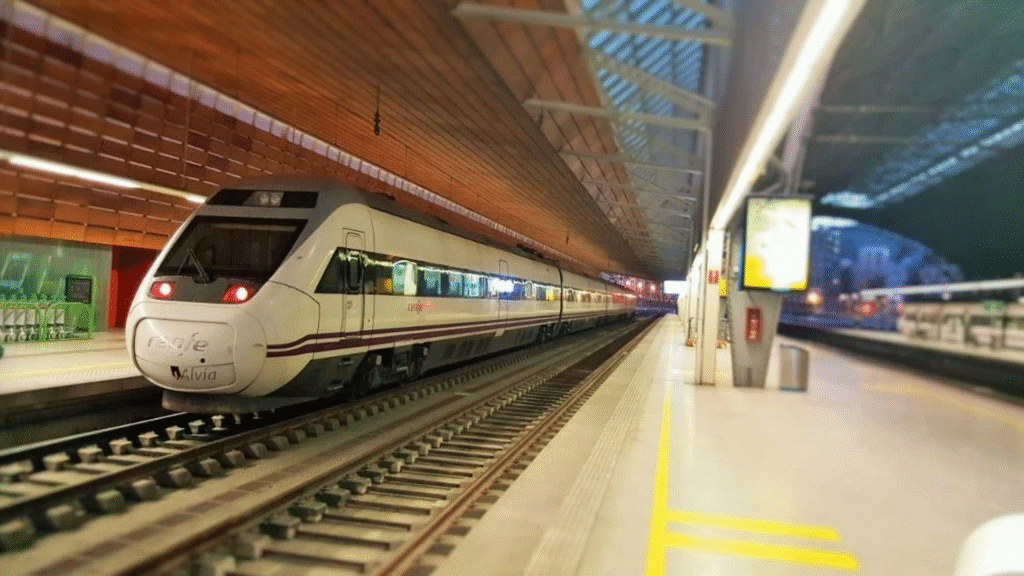
Spain’s Renfe Alvia trains connect major cities like Madrid and Barcelona with Pamplona, offering comfortable and efficient travel for San Fermín attendees. Cosmopolitours handles all transfers and timing to ensure a smooth arrival aligned with the festival’s key events.
How to Get to Pamplona for San Fermín
Transportation Options for Cultural Travelers
Summary of Transportation Options to Pamplona for San Fermín
Method | Duration | Cost Range | Cosmopolitours Recommendation |
|---|---|---|---|
Madrid Train | 3 hours | €27-€130+ | Best choice: Comfortable, scenic, cultural preparation time |
Madrid Flight | 1 hour flight + transfers | €90+ | Time-efficient: For tight schedules |
Barcelona Train | 4 hours | €30+ | Scenic route: Beautiful countryside approach |
Private Transfer | 5 hours from Madrid or Barcelona | €400-€600 | Ultimate comfort: Direct, luggage-friendly |
Rent a Car | 5 hours from Madrid or Barcelona | €60+ per day | Go for it: Great roads, easy drive.
NOTE: secure parking well in advance! |
What’s the best way to get to Pamplona? We Recommend the Train from Madrid or Barcelona. After arranging San Fermín travel for many cultural travelers, we recommend Renfe’s ALVIA trains (note: no AVE service runs to Pamplona). The four-hour or so journey allows you to appreciate Spanish countryside while arriving refreshed. Our clients use this time to review cultural context materials and prepare for meaningful engagement. Pro Tip: plan your trip to be able to spend 1-2 nights in Zaragoza, which is on the train route from either city.
Should I book my train early for San Fermín? Trains from both Madrid and Barcelona to Pamplona sell out completely during San Fermín week. Renfe (Spain’s National Train Company) typically limits bookings to 90 days, but occasionally opens earlier booking windows for high-demand periods like San Fermín. Start checking monthly, beginning 5 months in advance, when booking opens, book immediately. Use the official Renfe website directly, as third-party sites often don’t have access to all inventory or early booking windows.
Cosmopolitours Expert Take – Pro Tip: If budget allows, upgrade to “Confort” class on the trains. The larger seats, quieter carriages, and extra legroom are absolutely worth the additional cost during the festival rush. Standard class can be quite crowded with festival-goers.
Technical Note: Madrid-Pamplona trains are exclusively ALVIA services (Class 120 trains), which combine high-speed track (up to 250 km/h) with conventional lines. These trains change gauge automatically at Burgos, allowing them to use both high-speed and traditional Spanish rail networks.
Private Transportation Services: For our luxury Spain tours, we arrange private transfers with cultural stops en route, transforming travel time into an experience.
Is driving a good option for getting to Pamplona? Driving in Spain is easy. The highways are excellent and well-marked. If driving from Madrid, take the slightly longer route through the La Rioja wine region. From Barcelona, go through Zaragoza.
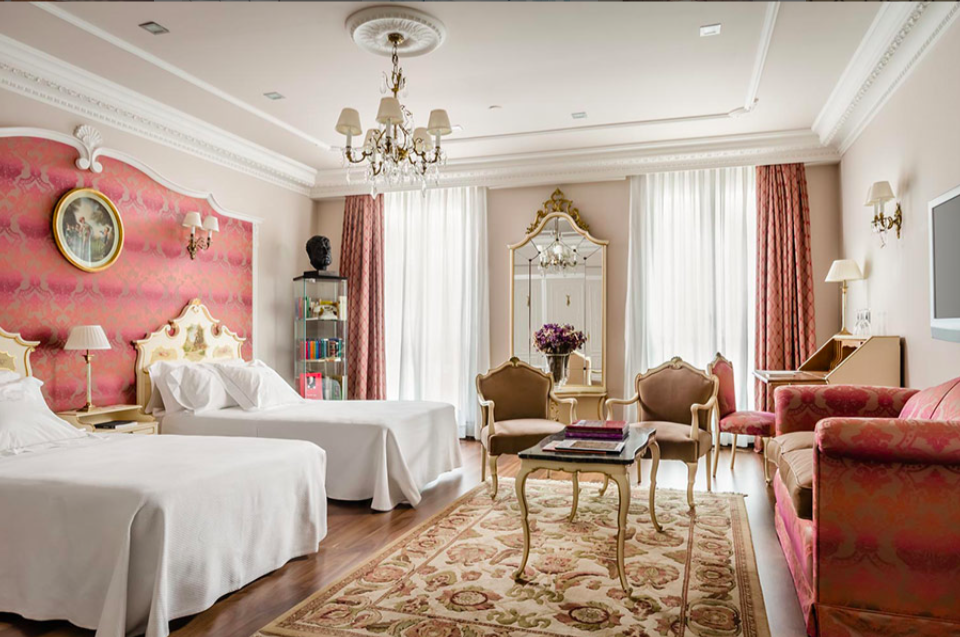
Hotel La Perla’s iconic Hemingway Suite blends Old World elegance with refined comfort in the heart of Pamplona. Overlooking the San Fermín festivities, this historic hotel is a favorite among discerning travelers seeking luxury and cultural immersion.
Where to Stay in Pamplona for the San Fermín Festival
Luxury Hotels with Cultural Depth
Personally Vetted Accommodations by Cosmopolitours Experts
Property | Category | Festival Rates | Cultural Significance | Cosmopolitours Assessment |
|---|---|---|---|---|
Gran Hotel La Perla | Historic Luxury | €600-€1,200 | Hemingway’s actual residence (Room 201, formerly 217) | Our top choice: Unmatched location and literary history |
Hotel Pamplona Catedral | Boutique Historic | €400-€600 | 19th-century convent conversion | Cultural immersion: Breakfast in former chapel |
Hotel Maisonnave | Modern Luxury | €300-€500 | Famous for traditional croquettes | Local favorite: Genuine Spanish hospitality |
Parador de Olite | Castle Hotel | €200-€400 | 40km away, medieval castle | Cultural escape: Royal heritage experience |
Gran Hotel La Perla, Sleep Where Hemingway Once Stayed: Hemingway’s actual room was 217 (renumbered as 201 after the 2007 renovation), which he chose specifically for its views over the main running route along Estafeta Street. The hotel offers 44 rooms, all of which are exterior-facing, with balconies overlooking either Plaza del Castillo or Estafeta Street, plus 5 attic rooms. We’ve negotiated preferred rates for our clients and can arrange private literary tours that uncover little-known stories and perspectives most visitors miss. Pro Tip: Book at least 9 months in advance.
Parador de Olite, Stay in a Medieval Castle Near Pamplona: For travelers seeking authentic Spanish hospitality without festival crowds, we recommend this stunning castle hotel 40 minutes from Pamplona. Stay in a 15th-century royal residence and commute to festival events—combining medieval luxury with cultural participation.
Why book with Cosmopolitours, your cultural travel partner for San Fermín: We don’t just book hotels—we craft experiences that help you connect with tradition. From VIP access to heritage-rich stays, to expert insight that prepares you for respectful and meaningful participation, we guide you every step of the way. If you’re dreaming of San Fermín 2026, we’re ready to make it unforgettable.
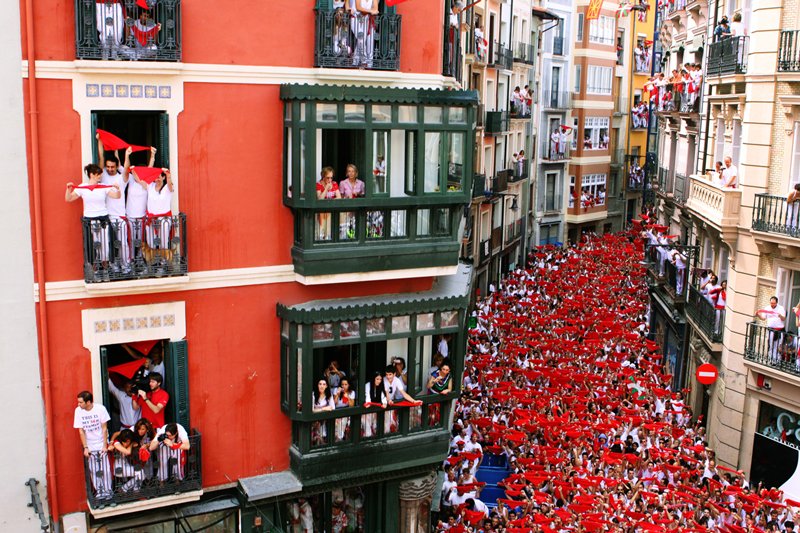
From elegant balconies to the sea of red below, Pamplona’s Plaza Consistorial bursts to life during the San Fermín opening ceremony. This moment marks the start of a cultural celebration where every vantage point becomes part of the story.
Planning Your Cultural Journey: Expert Timeline for 2026
When to Book for Optimal Cultural Access
11-10 Months Ahead (August 2025):
- Secure luxury accommodations
- Reserve exclusive experiences not available to the general public
6 Months Ahead (January 2026):
- Finalize transportation
- Book private guides for deeper cultural interpretation
- Arrange special access experiences (closed churches, private collections)
3 Months Ahead (April 2026):
- Confirm restaurant reservations at traditional establishments
- Schedule cooking classes and artisan workshops
- Plan cultural activities beyond festival dates
1 Month Ahead (June 2026):
- Cultural preparation (Read some Hemingway, watch documentaries)
- Traditional clothing sourcing and cultural significance explanation
- Final safety briefing and cultural etiquette review
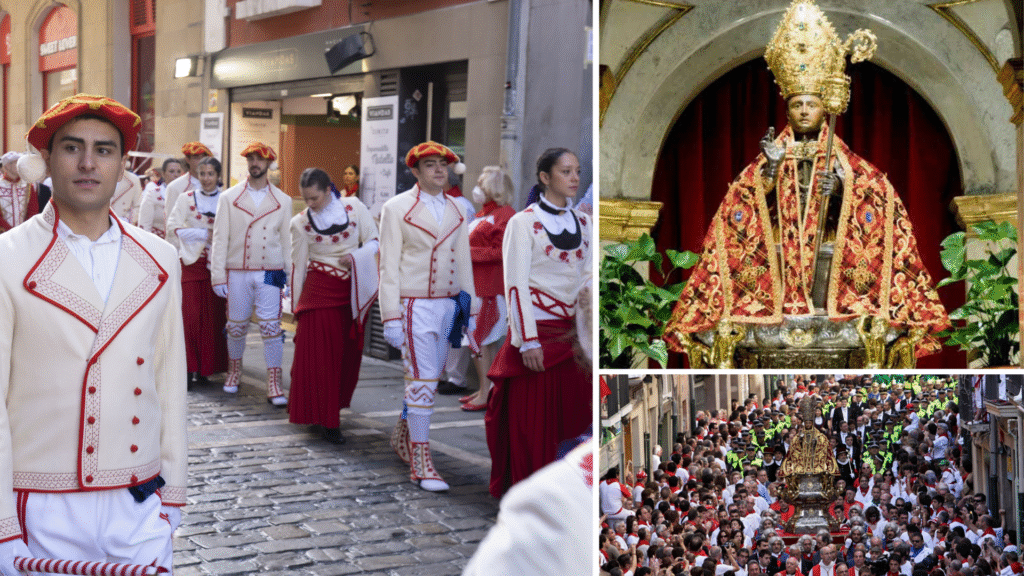
On July 7th, Pamplona awakens to the beat of tradition. From the vibrant youth in ceremonial attire to the solemn procession of Saint Fermín himself, this day marks the spiritual heart of the festival, a timeless celebration of devotion, identity, and living heritage.
Frequently Asked Questions about San Fermín Cultural Travel
Is San Fermín appropriate for travelers who oppose bullfighting?
Absolutely. Most festival activities have nothing to do with bulls—religious processions, traditional music, culinary celebrations, and cultural workshops offer meaningful engagement without ethical concerns.
How can we experience authentic Spanish culture in Pamplona during San Fermín?
Cosmopolitours’ cultural guides focus on the 95% of San Fermín that centers around community traditions, like dawn prayers with local families, artisan workshops, and traditional cooking. While some of these can be done independently, the most enriching experiences come from letting us plan every detail.
What’s the difference between tourist participation and cultural participation?
Cultural participation requires understanding historical context, respecting local customs, engaging with community members, and approaching traditions with humility rather than seeking personal thrills.
Can Cosmopolitours arrange private cultural experiences during San Fermín?
Yes. Our private Spain tours include exclusive access to closed historical sites, private cooking sessions with master chefs, and intimate cultural exchanges unavailable to general tourists.
How do you balance respect for traditions with modern ethical concerns? We provide honest cultural context, respect diverse perspectives, and offer meaningful alternatives that support local communities while honoring your personal values.
Still curious about how to experience San Fermín in a meaningful way?
Contact us to start crafting your private cultural journey in Spain.
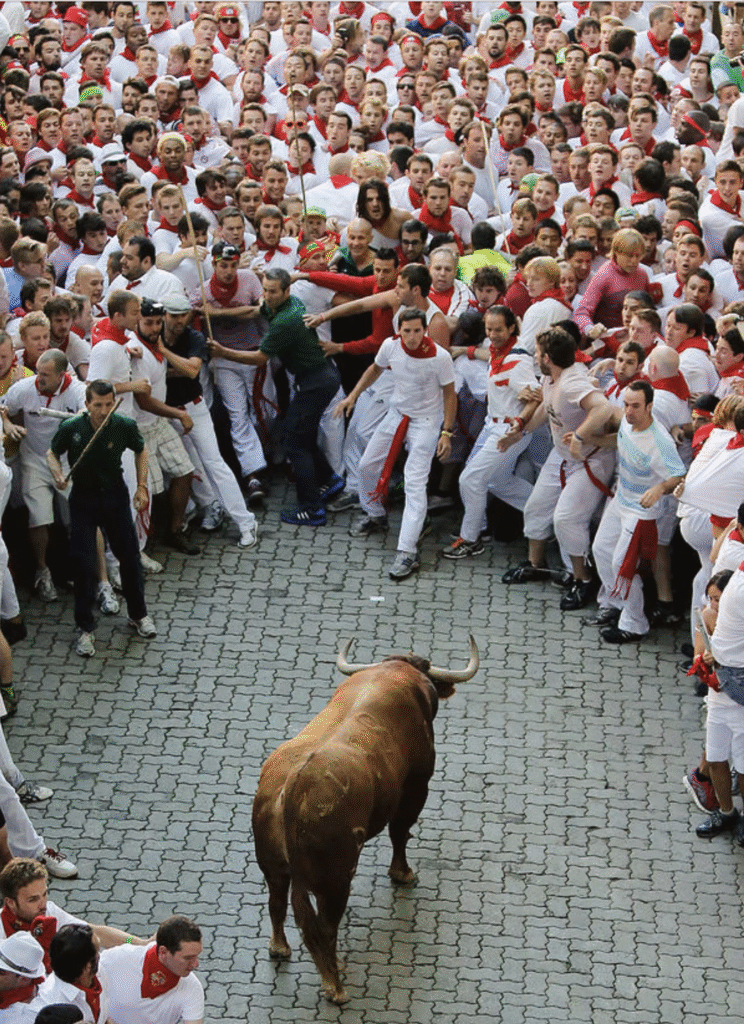
A split-second decision. A matter of respect and readiness. The bull run at San Fermín is not a thrill-seeking stunt; it’s a ritual rooted in centuries of tradition. Understanding the risks, cultural protocols, and personal limits is essential for anyone considering participation.
Is It Safe to Attend San Fermín? What Cultural Travelers Need to Know About Participation & Respectful Engagement
Understanding the Real Risks of the San Fermín Bull Run, With Cultural Context
Historical Safety Data: Injuries, Fatalities & Medical Support:
- Deaths since 1925: 15 total (last fatality: 2009)
- Annual injuries: 200-300 participants (mostly minor falls)
- Medical support: 200+ professionals, 15 stations along route
- Participation: 15,000-20,000 runners over 8 days
Cultural Safety Philosophy in Spain: Spanish culture views San Fermín participation through the lens of controlled risk and community support. Local spectators take genuine responsibility for visitor safety; this isn’t random kindness but embedded cultural practice.
What to Wear & Who Can Run: San Fermín Participation Rules
San Fermín Participation Rules: Age, Clothing & What Not to Bring:
- Age requirement: 18+ years (strictly enforced)
- Cultural attire: Traditional white and red clothing
- Prohibited items: Cameras, loose clothing, inappropriate footwear
What the San Fermín Outfit Means: Cultural Significance of Traditional Dress:
- White shirt and pants: Represents San Fermín’s sanctity
- Red pañuelo (scarf): Symbolizes his martyrdom
- Red faja (waistband): Traditional Basque regional accessory
- High Traction Shoes: Cobblestones are slippery squash or racquetball shoes are best.
Why Everyone Wears Red and White in Pamplona? Everyone in Pamplona, participants and spectators, wears traditional attire during the festival week. This isn’t a costume; it’s participation in shared community identity.
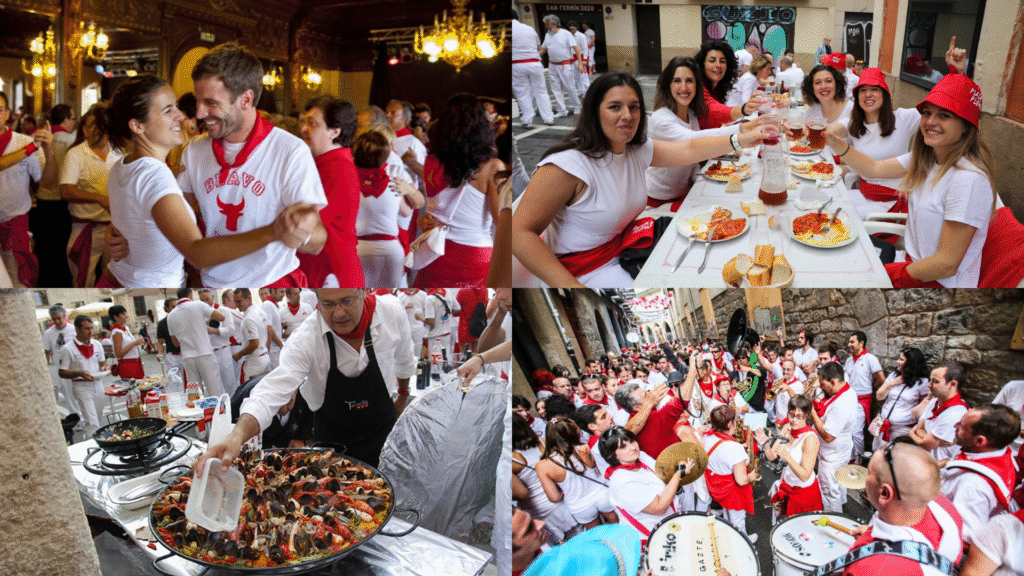
There’s more to San Fermín than adrenaline. From open-air meals with lifelong friends to spontaneous dancing, seafood feasts, and parading brass bands, this is where culture, joy, and tradition meet in the streets of Pamplona.
What to Do at San Fermín Besides the Bull Runs: Authentic Cultural Experiences for Travelers
Discover the 95% of San Fermín That's Not About Bulls
Religious Traditions & Spiritual Heritage:
- Daily processions honoring Saint Fermín with local families
- Dawn prayers at San Lorenzo Church
- Traditional Catholic ceremonies in medieval settings
- Camino de Santiago connections (Pamplona is a major pilgrimage stop)
Culinary Traditions & Local Food Culture:
- Traditional Navarrese cuisine in family-run restaurants
- Pintxos culture inherited from nearby Basque regions
- Local wine tastings at historic Navarre vineyards
- Cooking classes with grandmother chefs preserving regional recipes
Cultural Arts, Music, & Folk Traditions:
- Gigantes y Cabezudos (traditional giant puppet processions)
- Basque folk music sessions in neighborhood bars
- Artisan workshops maintaining centuries-old crafts
- Traditional dancing that continues until dawn
The Cosmopolitours Cultural Immersion Advantage: Our exclusive cultural experiences connect you with fourth-generation artisans, family-run vineyards, and master chefs who safeguard Spain’s living heritage. Our experiences are immersive, ethical, and deeply enriching, designed for travelers who want to engage, not just observe.
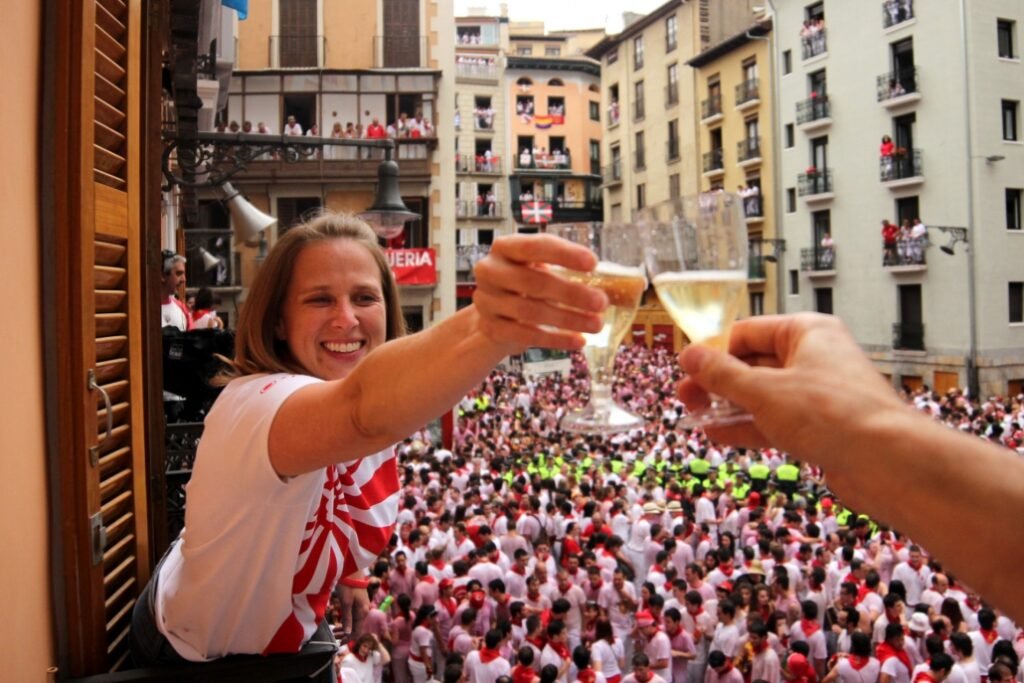
Experiencing San Fermín from a private balcony offers comfort, spectacular views, and a sense of intimacy amidst the city’s most electrifying celebration.
Experience San Fermín as Cultural Immersion, Not Tourism
Why Use Cosmopolitours for Your Spanish Cultural Journey
Our Cultural Authority:
- Two decades of cultural tourism expertise
- Personal relationships with local families, artisans, and cultural institutions
- Ethical framework respecting both tradition and modern perspectives
- Exclusive access to authentic experiences unavailable elsewhere
What Sets Our Pamplona Experience Apart:
- Cultural preparation, understand what you’re experiencing
- Local cultural interpreters who reveal hidden meanings and significance
- Flexible engagement options respecting your comfort level and values
- Authentic community connections that transform tourism into cultural exchange
Cosmopolitours Expert Take – Spain Cultural Philosophy: Luxury travel isn’t just about 5-star hotels, and private black car transportation. It’s about authentic cultural experiences that bring joy and new perspectives to your life. We don’t just show you Spain—we help you to feel it.
Ready to Experience San Fermín Authentically?
Transform your Spanish journey from tourism to cultural immersion. Our Pamplona cultural specialists design personalized experiences that honor local traditions while respecting your perspectives and values.
Plan Your Cultural San Fermín Journey | Speak with Our Spain Experts
Coming up in Part 3 of this San Fermín series, we’ll explore the ethical questions that many travelers ask: how do Spaniards really feel about bullfighting today? What traditions are evolving, what values remain, and how can you engage with cultural complexity responsibly?
At Cosmopolitours, we believe meaningful travel requires both access and ethics. That’s why we go beyond the surface—sharing cultural insight, fostering local relationships, and helping our travelers navigate nuanced traditions with curiosity and respect.
Cosmopolitours
Cosmopolitours is a luxury boutique tour operator creating bespoke cultural journeys across Latin America and the Mediterranean Basin. Since 2012, we’ve crafted immersive, private trips that connect discerning travelers with art, cuisine, heritage, and hidden gems. Every journey is custom-designed with care, cultural integrity, and white-glove service, for those who seek meaning, not just movement.
This article was reviewed by our Spain Travel Specialist team for accuracy and relevance to current conditions.

